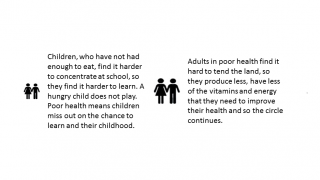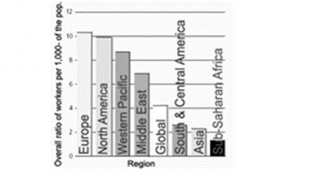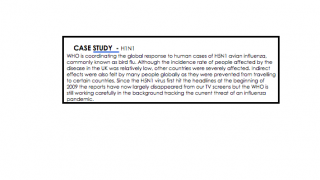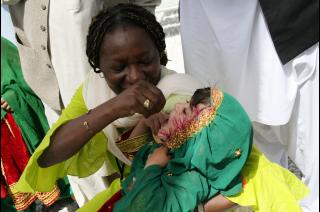What is health?
The word ‘health’ comes from the old English ‘hale’ which means ‘whole’ or ‘complete’. The WHO has given an international definition of health: "Health is a state of complete physical, mental and social well-being and not merely the absence of disease or infirmity."[1]
Health is also often thought of in terms of illnesses which endanger it like AIDs, Malaria and Tuberculosis – three of the most devastating diseases.
- When an illness or disease affect the lives of large proportions of people it is called an epidemic
- When an illness or disease extends over regions and countries it is called an pandemic
Internet, telephone, trans-Atlantic travel; the 21st century world is one that is increasingly interconnected and though this brings many benefits it also brings responsibility. Health is a shared responsibility, which means ensuring equal access to essential healthcare and collective action to health threats in different countries to look after those that are sick and to stop deseases from spreading.
- As many as two billion people around the world face health threats every day.[2]
Why is health important?
The way the body works depends on a person’s health. The body is designed to deal with everyday obstacles in order to be able to live life to the full, but poor health makes these everyday obstacles become larger and more difficult to overcome. For some the odds of leading a healthy life are stacked against them from the start.
- In 2008, 2.1 million the total number of children living with HIV – this is almost two times the population of children in Ireland.[3]
Health is important to everything a person does. Poor health affects people differently:

Poor health not only affects one person, but it has knock-on affects for others. Healthy children become healthy adults: people who create better lives for themselves, their communities and their countries. Good health is linked to a more promising future for richer and poorer countries alike. [In recognition of this link the United Nations has set up a series of eight time-bound goals, called the Millennium Development Goal, which have make health a key priority.]
‘It is health that is real wealth not pieces of gold and silver’ Ghandi
What are the challenges?
Virtually every aspect of the environment can affect physical or mental health in some way, either positively or negatively. Health hazards can emerge from a range of situations including emergencies, changes in health trends and pandemics such as AIDs, tuberculosis and malaria.
- Emergencies as a result of natural disasters, economic crises, or conflict are currently affecting the lives of people in more than 45 countries;[4]
- Changes in diet, physical activity, and tobacco use in both rich and poor countries hadramatically increased the risks of chronic diseases such as heart disease, cancer and diabetes;[5]
- Just six conditions: diarrhea, HIV/AIDS, malaria, measles, neonatal causes and pneumonia are the cause of almost 90 percent of all child deaths.[6]

Lack of facilities such as adequate supply of drugs, health workers and apparatus in countering the effects of poor health is part of the everyday struggles faced by many health workers.
- This chart shows the uneven distribution of health workers globally. Today, there are 1.3 health workers for every 1,000 people living in sub-Saharan Africa. The WHO recommends 2.5 health workers per 1,000 people.[7]
- More than half a million women die each year in pregnancy and childbirth. Most die because there is not enough skilled regular and emergency care.[8]
What does the UN do?
The WHO is the main UN body responsible for health. Since it was set up in 1948 the WHO has been responsible for setting global standards on health.
- By giving a single international name to drugs, WHO helps ensure that a prescription filled abroad is what the doctor ordered back home.[9]
The WHO also helps countries to put in place effective public health systems and builds up their capacity to respond and to manage all types of crises. It also targets efforts to eradicate diseases.
- The eradication of smallpox – a disease which had maimed and killed millions – in the late 1970s is one of WHO’s proudest achievements which coordinated the campaign between 1967 and 1979. Smallpox is the first and so far the only major infectious disease to have been successfully eradicated.
- Since its launch in 1988, the Global Polio Eradication Initiative has reduced the number of cases of polio by more than 99% – from more than 350 000 per year to 1956 in 2006. Spearheaded by national governments, WHO, and other organisations, it has immunised more than two billion children thanks to the mobilisation of more than 20 million volunteers and health workers. As a result, five million children are today walking, who would otherwise have been paralysed, and more than 1.5 million childhood deaths have been averted.


